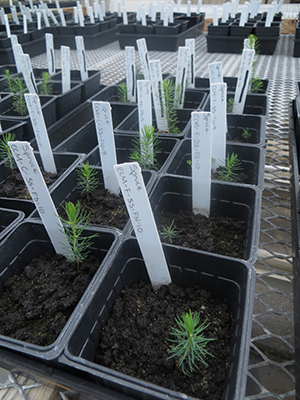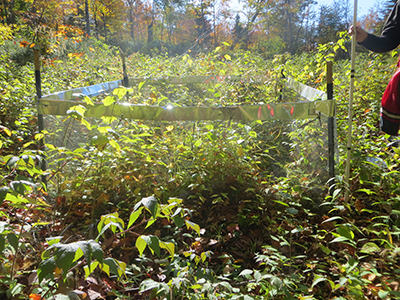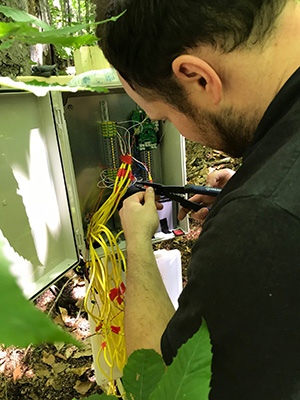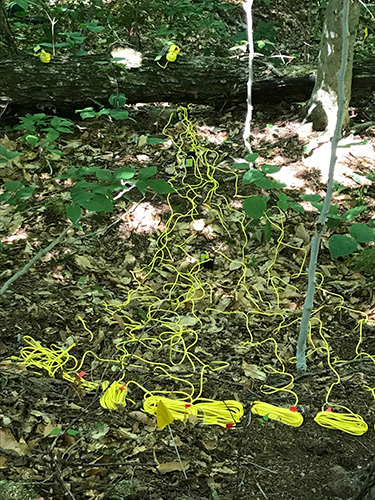Monitoring:
The ASCC installation at the Second College Grant represents the largest, replicated silviculture experiment in the northeastern United States. As such, it has presented a unique opportunity to evaluate the impacts of adaptation strategies on a wide range of response variables associated with ecosystem processes and biodiversity. Research partners from many institutions are working together to investigate the effectiveness of different silvicultural treatments aimed at creating adaptive ecosystems. Some of the response variables being measured are:
- Natural regeneration of planted seedlings
- Residual tree survival and growth
- Songbird, small mammals, insect, fungi, and other wildlife community responses
- Carbon pools, including living and downed woody materials and forest soils
- Litter and wood decomposition
- Moisture dynamics of downed woody debris
Progress & Next Steps:
Measurements of pre-treatment vegetation, carbon, and wildlife communities, as well as high-resolution LiDAR data were collected across research areas in the summer of 2017. Treatments were implemented in late summer-fall 2017 thanks in large part to the Herculean efforts of Dartmouth College Woodlands. Post-treatment data collections have occurred across 196 permanent plots in 2018, 2019, 2020, 2021, and 2022. In addition, several field tours and workshops for forest managers and wildlife biologists have occurred on the site since its installation, including the 2021 UNH Extension Mud Season Breakfast, 2021 Northeast Association of Fish and Wildlife Agencies Northeast Habitat Technical Committee Meeting, and 2023 field tour for resource management staff from the White Mountain National Forest.
Going forward, regular post-treatment monitoring will continue to assess the efficacy of the treatments. The team at the Second College Grant site will continue to analyze and communicate the results of their study to land managers, local landowners, and other scientists via workshops, field tours, and publications to encourage climate-adaptive management based off their successes.


Highlights from 2019:
Small Mammals, Mycorrhizal Fungi, and Forest Regeneration
Small mammals and mycorrhizal fungi are integral component to forests, yet much remains unknown about how their interactions contribute to the health and resiliency of forests. At the Second College Grant ASCC installation in northern New Hampshire, University of New Hampshire researchers are studying the role of small mammals (mice, voles, chipmunks) in dispersing mycorrhizal fungi and subsequent effects on forest regeneration.
Mycorrhizal fungi are important symbionts that colonize roots and assist trees with nutrient and water uptake. Timber harvests can significantly reduce mycorrhizal fungal diversity. However, small mammals that consume fungal fruiting bodies, like mushrooms and truffles, may be important for dispersing fungal spores in their scat, thereby repopulating regenerating forests with local fungi.


To assess linkages among small mammals, mycorrhizal fungi, and trees, postdoctoral fellow, Ryan Stephens, and advisors Dr. Rebecca Rowe and Dr. Serita Frey are conducting field surveys of small mammals in one-acre gap cuts at the Second College Grant ASCC site. They are using these surveys along with microscopy and genetic analysis of small mammal scat to determine the type, distance, and abundance of mycorrhizal spores that small mammals are dispersing into cleared forest gaps. The research team also has initiated a greenhouse experiment to determine the role of small mammal-dispersed spores on mycorrhizal colonization and growth of tree seedlings. They have also established fenced exclosures in the field, which prevent access by small mammals, to assess their influence on plant regeneration and soil fungal communities over time. Results of this research will shed light on how animals contribute to the response of forests to disturbance, including regeneration following timber harvest.
Author: Ryan Stephens, Postdoctoral Fellow, University of New Hampshire


Highlights from 2018:
The Frankenlog: Refining the science and technology of dead wood moisture monitoring

During the ASCC planning workshop for the Second College Grant installation in the hardwood forests of northern NH, it became apparent that although we expect precipitation to become more episodic in the future, we have very little understanding of how rain events effect the moisture of dead wood over short time steps. Dead and downed wood serves not only as a critical habitat and increases the structural complexity of forests but also may mitigate the overland flow of intense rain events. In contrast, dead wood can serve as sources of fuel during times of drought and extreme fire weather. Given recent advances in micro sensor development and associated data management, the potential exists to extend such technologies to this forest management issue.

Photo Credit: Chris Woodall,
USDA Forest Service Northern Research Station
In partnership with Dartmouth College’s Thayer School of Engineering and Plymouth State University, a downed dead sugar maple log and surrounding soil was monitored at the Hubbard Brook Experimental Forest with nearly 80 sensors to detect changes in moisture at 15-minute intervals during the summer of 2018. Based on initial findings, the hope is to develop a more streamlined deployment of sensors per log potentially using wireless technology for testing during the summer of 2019 at the Second College Grant ASCC installation.
As part of the project, numerous trees were intentionally felled and left on-site to evaluate their potential benefits. With a streamlined moisture monitoring technology in hand, we can more fully evaluate the modes by which down dead wood interacts with soil and rain fall events in terms of forest dynamics (e.g., regeneration, production, or fire hazards). Development of efficient dead wood moisture technology could inform wildfire management efforts around the Nation.


